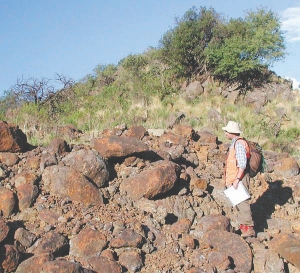VANCOUVER — A batch of drill results from the Las Aguilas West deposit, in Argentina, has returned significant platinum values for joint-venture partners Castillian Resources(CT-V, CTIIF-O) and Marifil Mines (MFM-V, MFMLF-O).
Hole 25 intersected a 10.3-metre interval (starting 70.6 metres downhole) grading 0.42% nickel, 0.54% copper, 1.7 grams platinum per tonne and 0.4 gram palladium hosted in a north-northeasterly striking pyroxenite to melanogabbronorite dyke structure. The section included 1 metre that ran 5.7 grams platinum.
Another hole, 49, cut 7.4 metres of 0.56% nickel, 0.81% copper, 1.2 grams platinum and 0.5 gram palladium; and included 1 metre of 4.6 grams platinum.
The drill effort at the project, located in central Argentina’s San Luis province, is targeting nickel-copper- platinum group metals in the San Luis belt mafic-ultramafic intrusive complex. Mineralization mostly occurs as disseminated to net-textured sulphides (primarily pyrrhotite, pentlandite and chalcopyrite) that also carry cobalt, platinum, palladium and minor gold.
Castillian says 15 holes from its Las Aguilas West drill program have returned intervals exceeding 1 gram platinum.
“There are relatively few nickel systems that are characterized by such enrichment of platinum and palladium,” said David Gower, Castillian president and CEO, in a statement. “Deposits with similar nickel and copper grades such as the Agua Blanca deposit in Spain are currently being mined profitably, hence the potential significance of these results.”
Mineralization at Las Aguilas West has not been closed off to the north or south and remains open at depth in the deposit’s northern half. The tabular mineralized zone ranges from 2-21.5 metres in true thickness with an average of roughly 10-12 metres in the drill intersections.
The latest results will be incorporated into an upcoming resource estimate. Castillian’s drill program –spaced at about 25-metre centres –has tested the West deposit from surface to roughly 150 metres vertical depth and along about 375 metres of strike length.
The project area — previously classified as a national mineral reserve — was under control of the Argentine government until 1998. During that tenure, about 10,000 metres of drilling was completed and led to a historic resource estimate of 2.2 million tonnes at 0.52% nickel, 0.51% copper and 0.036% cobalt using a 0.3% nickel cutoff grade — split between the two distinct sulphide bodies (East and West).
Early last year, Castillian acquired an option whereby it can earn a 50% interest in Las Aguilas from Marifil through completing US$3 million in exploration by late 2010 and making payments totalling US$490,000 by late 2009. It can boost its interest to 60% by spending an additional US$2 million on the project and delivering a feasibility study. A final 5%, for a total of 65%, can be had by arranging project development financing.
Shares of both juniors were lifted by the platinum grades, with Castillian closing up 12 at 57, and Marifil gaining 12 to close at 58.


Be the first to comment on "Castillian, Marifil cut platinum in Argentina (March 03, 2008)"